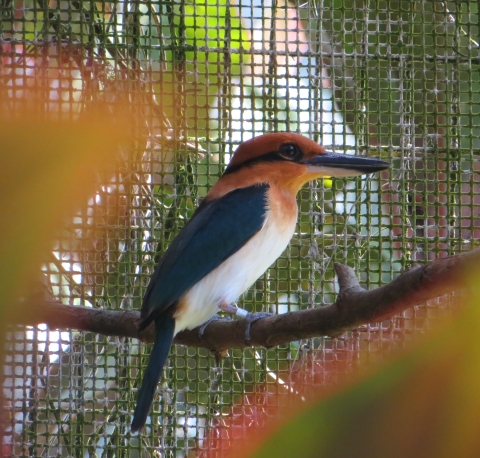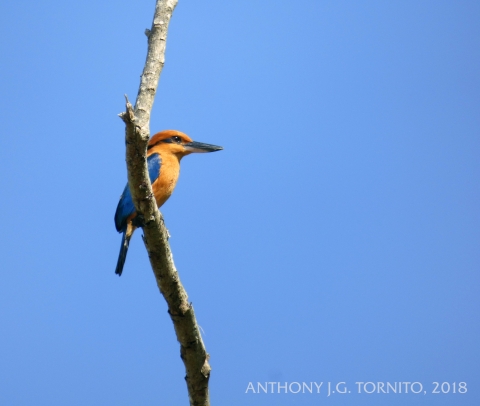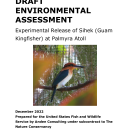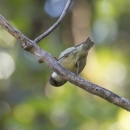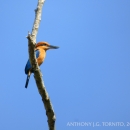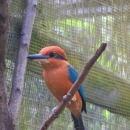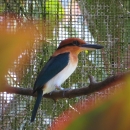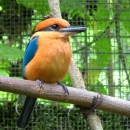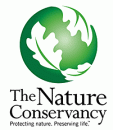States
Guam, HawaiiEndemic to the forest of Guam, the sihek (Guam kingfisher, Todiramphus cinnamominus)is striking in appearance. Its body is adorned with cinnamon-orange feathers, while its wings and tail shine in a bright blue. A black streak also dashes from its dark eyes towards the back of its head. It has a long, heavy bill that indicates its predatory feeding behavior, as sihek feeds entirely on animal prey including skinks, geckos, spiders, beetles, and land crabs. They are a “sit and wait predator” that perch motionless on exposed branches and swoops down to capture prey off the ground with their bill. However, sometime during the 1950s this predator became the prey as brown treesnakes were accidently introduced into Guam’s forest and devastated Guam's avifauna populations, including sihek.
In 1988, sihek was extinct in the wild and only existed in a few captive breeding facilities. Currently sihek is managed under human care at Association of Zoos and Aquariums facilities in the U.S. mainland and at Guam Department of Agriculture Division of Aquatic and Wildlife Resources. However, like all forest birds sihek belongs in the wild and space for endangered and extinct-in-the-wild species are limited. Efforts to establish a wild population are under way, with the intent of ultimately reestablishing sihek on Guam, once brown treesnakes can be sufficiently managed.
- The Proposal
- Draft Environmental Assessment
- Final Rule
- Sihek Arrives on Palmyra Atoll
- Sihek Released to the Wild
The Proposal
August 31, 2022 - The U.S. Fish and Wildlife Service proposed the conservation introduction of the sihek to The Nature Conservancy's Cooper Island nature preserve and the Palmyra Atoll National Wildlife Refuge. Captive bred sihek would be released at Palmyra Atoll as an experimental population under section 10(j) of the Endangered Species Act, which designates the population as experimental to support the reintroduction of the at-risk species to foster long-term recovery.
While the conservation introduction of sihek at Palmyra Atoll is not meant to be a permanent population, it will allow scientist to monitor and learn how sihek respond to being in wild conditions after more than 30 years existing under human care. This will also allow the tailoring of future release and monitoring techniques of future sites
These recovery efforts have been an ongoing partnership of the “The Sihek Recovery Program,” a collaboration of federal, state, and private partners made up of the U.S. Fish and Wildlife Service, Guam Department of Agriculture Division of Aquatic and Wildlife Resources, The Nature Conservancy, Association of Zoos and Aquariums, Sedgwick County Zoo, and ZSL (Zoological Society of London). Once released on Palmyra, the sihek habitat use, foraging activities, and breeding, amongst other behavioral activity, will be observed and documented.
Draft Environmental Assessment
December 21, 2022 - A draft environmental assessment was released by the Service. The National Environmental Policy Act requires federal agencies to identify and disclose the anticipated effects of federal actions to human environments. The experimental release of sihek on Palmyra Atoll consists of the issuance of a new Federal Rule under section 10(j) of the Endangered Species Act. The draft environmental assessment analyzes potential effects to the human environment, alternative actions, and whether such effects may be significant.
Final Rule
April 4, 2023 - The final rule for the nonessential, experimental population of sihek to Palmyra Atoll was published in the Federal Register. Based on the best scientific and commercial data available (in accordance with 50 CFR 17.81), the Service finds that introducing sihek to Palmyra Atoll, with the regulatory provisions in this final rulemaking, will further the conservation of the species. The nonessential experimental population status is appropriate for the introduced population because we have determined that it is not essential to the continued existence of the species in the wild.
Sihek Arrive on Palmyra Atoll
August 28, 2024 - Nine sihek were transported from Wichita, Kansas, to The Nature Conservancy’s (TNC) preserve and research station on Cooper Island at Palmyra Atoll. The four females and five males will remain under supervised care in aviaries until their caretakers are confident they can be released into the wild. Each bird will be fitted with tiny trackers, allowing the team to monitor their activity as they settle into their new habitat throughout the atoll. These releases will be repeated annually until 20 sihek have successfully established themselves as breeding pairs. Palmyra Atoll will provide the sihek a predator-free wild home to establish a breeding population, with the main goal of one day returning the species to Guam once the threat from snakes is controlled.
Sihek Released to the Wild
September 23 2024 - Six sihek are now living in the wild, in the tropical forests of Palmyra Atoll. This release marks the first time since the 1980s these beautiful birds will reside in the wild. The birds have displayed very promising behavior such as eating right away, instinctually preening when they experienced their first rainfall and successfully hunting the spiders, geckos and crabs they will rely on for food.
Prior to release from the aviaries, each sihek was given a health exam. A tiny radio tracker was fitted to each bird before release so the project team can monitor their movements as they settle into new habitat at locations across the atoll. Sihek are a territorial species, and the team expects the birds will establish home ranges quickly, which will also help with locating and monitoring them with a special focus on habitat use, foraging, and eventual breeding. Supplemental food will also be available to help them transition to the wild.
Frequently Asked Questions
Q: What is The Sihek Recovery Program?
A: The Sihek Recovery Program is a global collaborative of conservationists dedicated to recovering one of Guam’s most iconic native species, the sihek. Extinct in the wild since 1988 due to the accidental introduction of the invasive brown tree snake, sihek now survive only under human care in a facility run by Guam Department of Agriculture’s Division of Aquatic and Wildlife Resources and at Association of Zoos and Aquariums (AZA) institutions on the US mainland. Until threats on Guam are mitigated, the Sihek Recovery Program is working to identify suitable release locations elsewhere to help grow the global sihek population, safeguard the species against extinction, and refine release methods to support the ultimate goal of returning sihek home to Guam. The Sihek Recovery Program is made up of representatives from the following organizations: U.S. Fish and Wildlife Service, Guam Department of Agriculture Division of Aquatic and Wildlife Resources, The Nature Conservancy, Association of Zoos and Aquariums, Sedgwick County Zoo, and ZSL (Zoological Society of London)
Q: Is Palmyra Atoll the "placeholder" until Guam can be restored to a point that sihek can be reintroduced there?
A: The release at Palmyra Atoll is a first step toward recovering sihek on Guam. During the Palmyra release, scientist hope to learn how the birds respond to being in wild conditions after more than 30 years existing under human care, and to tailor the release and monitoring techniques for future releases at future sites.
Q: If successful, will more be released onto the island?
A: The current estimated carrying capacity for sihek at Palmyra Atoll is 20 breeding pairs. The current plan is to release up to nine birds per year, with a target of 10 breeding pairs. This will give the population a solid foundation with room to grow through breeding.
Q: How does this help the sihek recover?
A: We will gather information from observing the species under wild conditions, develop suitable release and monitoring methods, assess how much human intervention might be needed to support a wild population, and develop guidelines for improving future release efforts. Wild-hatched sihek could be a complementary source, alongside captive-bred birds, for translocation to Guam or other sites.
Further, captive breeding spaces are limited for this extinct-in-the-wild species. Creating a wild population is currently the best way to expand the global sihek population. We anticipate the introduction of sihek at Palmyra Atoll will also help invigorate the captive breeding program by motivating more institutions to join the program, ultimately resulting in a larger captive population with increased genetic diversity.
Q: What sort of impact could this have on the species living on Palmyra Atoll?
A: We expect the sihek to have minimal impact on the native species living at Palmyra Atoll. There are no forest bird species at Palmyra that sihek would compete with or be or to impacted by predation.
News Releases
- U.S. Fish and Wildlife Service Proposes an Experimental Population of Sihek at Palmyra Atoll with the Help of Partners
- U.S. Fish and Wildlife Service Announces Draft Environmental Assessment for Proposed Experimental Population of Sihek at Palmyra Atoll
- U.S. Fish and Wildlife Service Announces the Final Rule for the Experimental Population of Sihek on Palmyra Atoll

